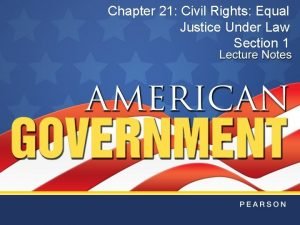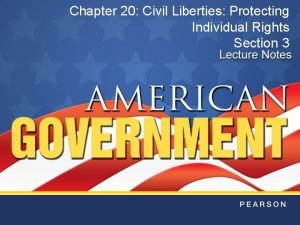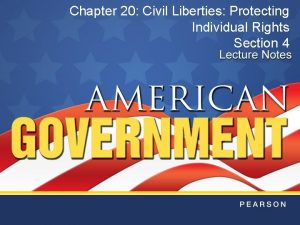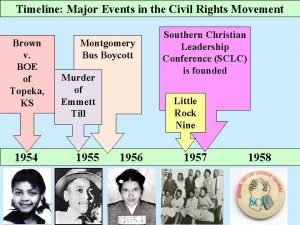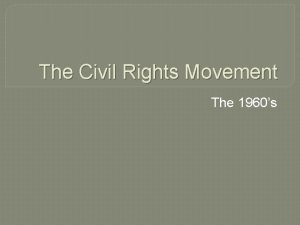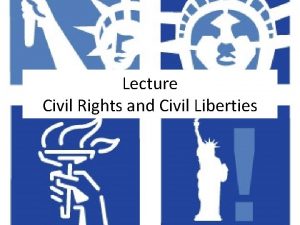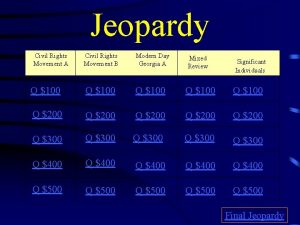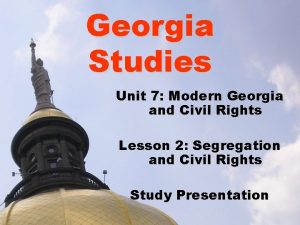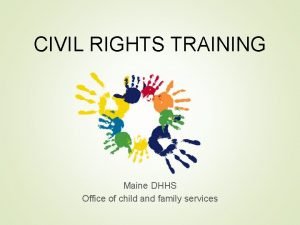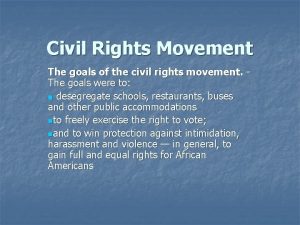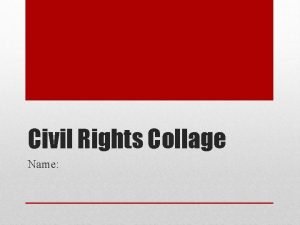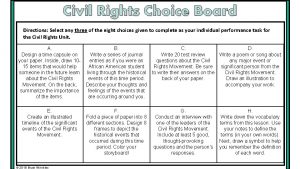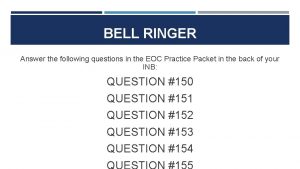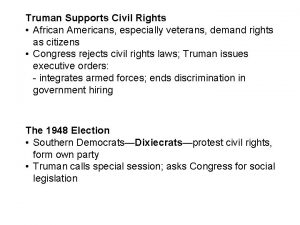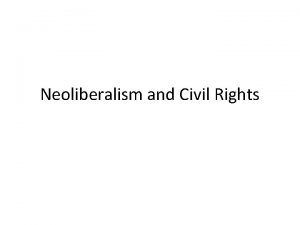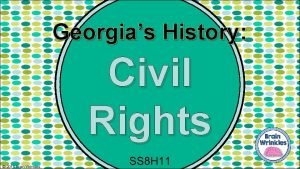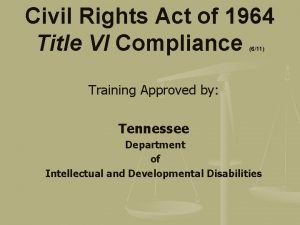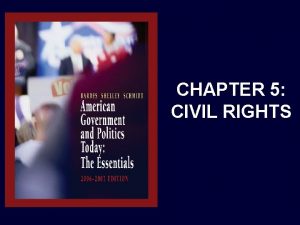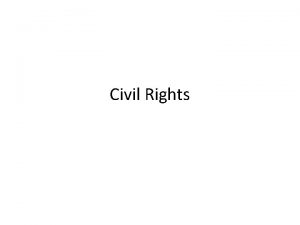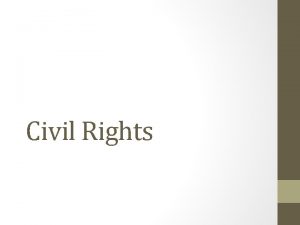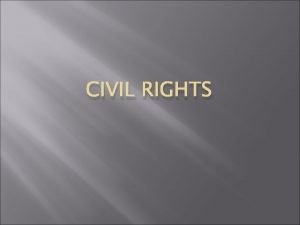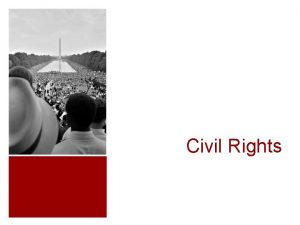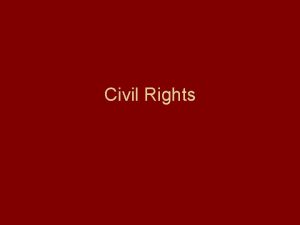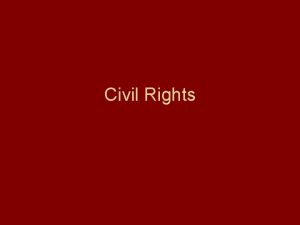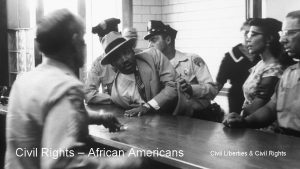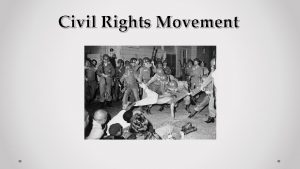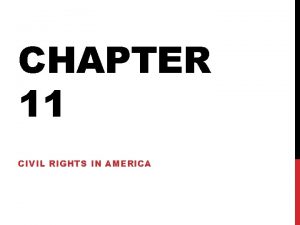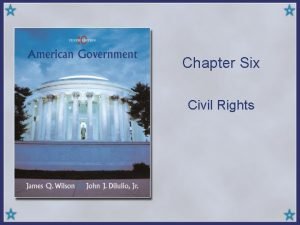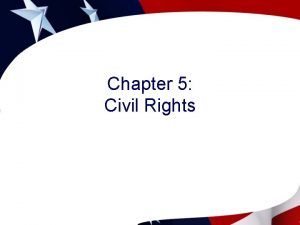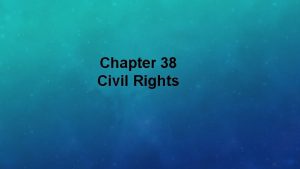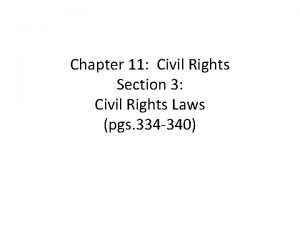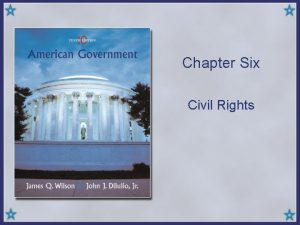Chapter 5 Civil Rights Civil Rights What is



























- Slides: 27

Chapter 5: Civil Rights

Civil Rights • What is the legal basis for civil rights? • How has the equal protection clause of the Fourteenth Amendment historically been enforced? • What is the critical Supreme Court ruling in the battle for equal protection? • How has Congress tried to make equal protection a reality? • In what areas did the civil rights acts seek to provide equal access and protection?

Civil Rights • • The equal protection clause Plessy v. Ferguson: Separate but equal Racial discrimination after World War II Civil rights after Brown v. Board of Education • The civil rights acts

The Equal Protection Clause • The Fourteenth Amendment provides that “no State shall make or enforce any law which shall deny to any person within its jurisdiction the equal protection of the laws. ”

Equal Protection Clause • The Supreme Court refused to apply the equal protection clause of the Fourteenth Amendment to private businesses in the Civil Rights Cases (1873)

Civil Rights Plessy v. Ferguson • In Plessy v. Ferguson (1896), the Supreme Court upheld segregation as long as the facilities were equal. • The doctrine of “separate but equal” was born.

Civil Rights Racial Discrimination after World War II • President Truman attempted to end segregation after World War II. • The Supreme Court began to strike down segregation when the states failed to provide equal facilities.

Civil Rights Brown v. Board of Education • In Brown v. Board of Education (1954), the Supreme Court struck down the separate but equal doctrine and ordered the desegregation of the nation’s public schools.

Civil Rights After Brown v. Board of Education • The Supreme Court used Strict Scrutiny to put the burden on the state government to establish the constitutionality of its actions. • Segregation created by law (de jure) was struck down. • Segregation that occurs through housing patterns exists even today.

Civil Rights The Civil Rights Acts • The Civil Rights Act of 1875 was declared unconstitutional. • The Civil Rights Acts of the 1950 s and 1960 s were upheld on a variety of grounds, including the power to regulate interstate commerce.

Copyright © by W. W. Norton and Company 2003



The Universalization of Civil Rights • What groups were spurred by the provision of the Civil Rights Act of 1964? • What is the politics of the universalization of civil rights?

The Universalization of Civil Rights • • • Women and gender discrimination Latinos and Asian Americans Native Americans Disabled Americans Gays and lesbians

Women and Gender Discrimination • Women have always been politically active. • However, it was not until the 1960 s that a movement was begun to push for equal rights for women. • The equal rights amendment was defeated in 1982.

Latinos and Asian Americans • Groups like MALDEF and LULAC have pushed for equal rights for Latinos. • The Asian Law Caucus strives for equal rights for Asian Americans.

Native Americans • Native Americans were not granted citizenship until 1924. • The American Indian Movement (AIM) was active in the 1960 s and 1970 s.

Disabled Americans • The Americans with Disabilities Act of 1990 was a significant victory for groups such as the Disability Rights Education and Defense Fund.

Gays and Lesbians • The Human Rights Campaign Fund is the primary national political action committee working for equal protection for gays and lesbians. • The Supreme Court’s decision in Romer v. Evans (1996) suggests a move toward the recognition of civil rights.

Affirmative Action • What is the basis for affirmative action? • How does affirmative action contribute to the polarization of the politics of civil rights? • How does the debate about affirmative action reflect the debate over American political values?

Affirmative Action • The Supreme Court and the burden of proof • Referendums on affirmative action • Affirmative action and American political values

Affirmative Action • Affirmative action encompasses government policies or programs that seek to redress past injuries against specified groups by providing access to education and employment opportunities. • The difficulty is determining the best way to provide opportunity: – Quotas – Legal action

The Supreme Court and the Burden of Proof • In Bakke v. UC at Davis (1978), the U. S. Supreme Court recognized the importance of affirmative action programs but rejected the procedures used the university to ensure minority admissions. • Specifically, the use of quotas was found to violate the equal protection rights of Mr. Bakke.

The Supreme Court and the Burden of Proof • Federal courts have weakened the impact of affirmative action over the last ten years. • The Supreme Court in Adarand Constructors (1995) rejected race-based preferences in government contracts. • The Fifth Circuit rejected the admissions criteria for admission to U. T. Law School in Hopwood (1996).

Referendums on Affirmative Action • The California Civil Rights Initiative (Proposition 209) outlawed affirmative action programs in the state and local governments. • A similar attempt failed in Houston, Texas.

Affirmative Action and American Political Values • Affirmative action efforts have contributed to the polarization of the politics of civil rights. • Americans seem split down the ideological center over the need for affirmative action.
 Civil rights and civil liberties webquest
Civil rights and civil liberties webquest Chapter 21 civil rights equal justice under law
Chapter 21 civil rights equal justice under law Chapter 20 civil liberties protecting individual rights
Chapter 20 civil liberties protecting individual rights Chapter 14 postwar prosperity and civil rights
Chapter 14 postwar prosperity and civil rights Chapter 14 postwar prosperity and civil rights
Chapter 14 postwar prosperity and civil rights Chapter 20 civil liberties protecting individual rights
Chapter 20 civil liberties protecting individual rights Chapter 20 civil liberties protecting individual rights
Chapter 20 civil liberties protecting individual rights Civil rights timeline of events
Civil rights timeline of events Civil rights sitins
Civil rights sitins Mother of the modern day civil rights movement
Mother of the modern day civil rights movement Define civil rights
Define civil rights Civil rights movement jeopardy
Civil rights movement jeopardy Unit 7: modern ga and civil rights
Unit 7: modern ga and civil rights Usda civil rights training
Usda civil rights training Civil rights training child nutrition programs
Civil rights training child nutrition programs Civil rights movement goal
Civil rights movement goal Civil rights in child nutrition programs
Civil rights in child nutrition programs Civil rights graphic organizer
Civil rights graphic organizer Civil rights collage
Civil rights collage Civil rights choice board
Civil rights choice board Civil rights bell ringers
Civil rights bell ringers Truman supports civil rights
Truman supports civil rights Characteristics of civil rights
Characteristics of civil rights Civil rights cloze notes 1
Civil rights cloze notes 1 Sibley commission definition
Sibley commission definition Federally protected classes
Federally protected classes Title vi of the civil rights act of 1964
Title vi of the civil rights act of 1964 Civil rights in child nutrition programs
Civil rights in child nutrition programs

